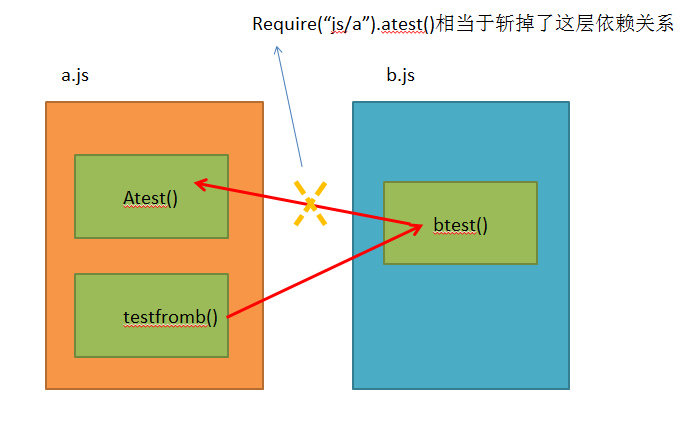RequireJS および JQuery_javascript スキルに基づいたモジュラー プログラミングにおける日常の問題の分析
js のコード ロジックはますます重くなるため、js ファイルには数千行が含まれる場合があり、これは開発やメンテナンスにとって非常に不利です。最近、ロジックの重い JS をモジュールに分割しています。requirejs と seajs のどちらを使用するか悩んだのですが、最終的には requirejs を使用することにしました。やっぱり公式文書のほうが専門的ですね…
しかし、完全な公式ドキュメントがあっても、jquery-ui の使用など、依然として多くの問題に遭遇します。
以下は、私が遭遇した問題とその解決策を段階的に説明したものです。
AMD と CMD の理解
AMD(非同期モジュール定義)の代表例はrequirejs、CMD(共通モジュール定義)の代表例はタオバオのseajsです。
これらに共通しているのは、すべて js を非同期でロードすることです。ただし、require.js はロード直後に実行されるのに対し、seajs は main 関数に入って実行する必要があるまで実行されないという点が異なります。
seajsを使用すると初期読み込みや実行効率は高くなりますが、使用中にjsを取得して実行する場合があるためラグが発生し、ユーザーエクスペリエンスに影響を与える可能性があります(試していないので間違っていたら、驚かないでください)。このとき、requirejs は読み込まれたすべての js を最初に実行します。モジュール内にいくつかの実行メソッドがある場合、それらは希望する順序で実行されない可能性があります。
したがって、非同期プログラミングに慣れていて完全なドキュメントが必要な場合は、requirejs を使用することをお勧めします。実行順序に特別な要件を設けて開発を容易にしたい場合は、seajs を使用することもできます。
requirejs で循環依存関係の問題を解決する方法
定義したモジュール a がモジュール b を使用し、モジュール b がモジュール a を使用する場合、循環依存関係例外がスローされます。
たとえば、循環依存関係の例をここに書きました。
メインページ:
<!DOCTYPE html> <html> <head> </head> <body> <script data-main="test.js" src="lib/require.js"></script> </body> </html>
メインメソッド:
requirejs.config({
baseUrl: './'
});
requirejs(['js/a'],function (a){
console.log("in test");
a.testfromb();
});a.js モジュールでは、test() メソッドが b を呼び出すメソッドを提供し、testfromb() メソッドが b のメソッドを呼び出します
define(function(require){
var b = require("js/b");
console.log("in a");
return {
atest:function(){
console.log("test in a");
},
testfromb:function(){
console.log("testfromb in a");
b.btest();
}
}
});モジュール b では、a のメソッドが呼び出されます。
define(function(require){
var a = require("js/a");
console.log("in b");
return {
btest:function(){
console.log("test in b");
a.atest();
}
}
});これは a が b のメソッドを呼び出すのと同等ですが、b のメソッドは a のメソッドに依存するため、循環依存関係が作成されます。ブラウザでエラーが表示されます:
Uncaught Error: Module name "js/a" has not been loaded yet for context: _
公式ドキュメントによると、これは設計上の問題であり、可能な限り回避する必要があります。では、避けられない場合はどうすればいいのでしょうか?モジュール b は次のように変更できます:
define(function(require){
// var a = require("js/a");
console.log("in b");
return {
btest:function(){
console.log("test in b");
require("js/a").atest();
}
}
});ここでは、モジュールをロードする前に、test() メソッドが実行されるまで待機します。この時点でモジュール a は明らかにロードされています。出力情報を確認できます:
in b a.js:3 in a test.js:6 in test a.js:9 testfromb in a b.js:6 test in b a.js:6 test in a

同様に、a を変更すると機能しなくなる可能性があります。これは、モジュールのロード順序が b から始まるためです。
循環依存関係のソースコードについては、クラウドディスク
を参照してください。
requirejs で jquery を使用する方法
jquery を比較的簡単に使用したい場合は、対応する依存関係を main.js に直接追加するだけです。
requirejs.config({
baseUrl: './',
paths:{
'jquery':'lib/jquery'
}
});
requirejs(['jquery'],
function ($){
$('#test').html('test');
});requirejs で jquery プラグインを使用する方法
jquery プラグインの場合、一般的なアプローチは、jquery オブジェクトを渡し、この jquery オブジェクトに基づいてプラグインの対応するメソッドを追加することです。
まず、jquery プラグインの依存関係を追加する必要があります。例として、jquery-ui と jquery-datatables の 2 つのプラグインを示します。
requirejs.config({
baseUrl: './',
paths:{
'jquery':'lib/jquery',
'jquery-ui':'lib/jquery-ui',
'jquery-dataTables':'lib/jquery.dataTables'
},
shim:{
'jquery-ui':['jquery'],
'jquery-dataTables':['jquery']
}
});
requirejs(['jquery','jquery-ui','jquery-dataTables'],
function ($){
....
});jquery プラグインはすべて jquery に依存する必要があるため、依存関係を shim で指定できます。
上記の使用方法に加えて、commonJS スタイルの呼び出しも使用できます。
define(function(require){
var $ = require('jquery');
require('jquery-ui');
require('jquery-dataTables');
//下面都是测试,可以忽略
var _test = $('#test');
_test.selectmenu({
width : 180,
change : function(event, ui) {
console.log('change');
}
});
return {
test:function(){
//测试jquery-ui
_test.append($('<option>test1</option><option>test1</option>'));
_test.selectmenu("refresh");
//测试jquery-datatables
var _table = $('table');
_table.dataTable();
}
}
});ただし、上記のコードを実行すると、例外が報告されます:
Uncaught TypeError: _table.dataTable is not a function
dataTables は require スタイルのモジュールではないため、このように直接導入すると内部の匿名関数が実行されません。最後の行で $ オブジェクトを渡して、その匿名関数を変更できます:
*/ return $.fn.dataTable; //}));原来是这样 }($)));//这里增加执行这个匿名函数,并且传入$对象。 }(window, document));
This is also a method of searching on the Internet, but the principle is due to lack of experience....
You can refer to the cloud disk for the sample code. Since the imported resources are not complete, an error will be reported and can be ignored. Because being able to execute the UI plug-in means it has been successful.
Problems using jquery-ui with requirejs
Since requirejs will be executed immediately after loading the js file, if your jquery ui plug-in needs to refresh the DOM page, it may cause the page's events to fail.
For example, after your module is loaded, a click event is bound to a certain element $('#test') on the page. However, if a certain UI plug-in is used, the plug-in will re-render the DOM element, and the click event corresponding to test will become invalid.
Solution:
•Delay event binding until the DOM element is rendered and then manually trigger the binding;
•Event capture can also be used instead of event binding of DOM elements (too troublesome...not recommended).
For example, in the DOM reconstructed JS module, the code that executes rendering is as follows:
require("xxx").initEvents();
Common scenarios:
For example, I use the jquery-steps UI plug-in on the page, which will re-render the page. This caused the events I originally bound to become invalid... I could only postpone binding until the js page was reconstructed and then bind again.
The above is the entire description of the editor’s analysis of daily problems in modular programming with RequireJS and JQuery. I hope it will be helpful to everyone!

ホットAIツール

Undresser.AI Undress
リアルなヌード写真を作成する AI 搭載アプリ

AI Clothes Remover
写真から衣服を削除するオンライン AI ツール。

Undress AI Tool
脱衣画像を無料で

Clothoff.io
AI衣類リムーバー

Video Face Swap
完全無料の AI 顔交換ツールを使用して、あらゆるビデオの顔を簡単に交換できます。

人気の記事

ホットツール

メモ帳++7.3.1
使いやすく無料のコードエディター

SublimeText3 中国語版
中国語版、とても使いやすい

ゼンドスタジオ 13.0.1
強力な PHP 統合開発環境

ドリームウィーバー CS6
ビジュアル Web 開発ツール

SublimeText3 Mac版
神レベルのコード編集ソフト(SublimeText3)

ホットトピック
 7615
7615
 15
15
 1387
1387
 52
52
 88
88
 11
11
 29
29
 136
136
 フロントエンドのサーマルペーパーレシートのために文字化けしたコード印刷に遭遇した場合はどうすればよいですか?
Apr 04, 2025 pm 02:42 PM
フロントエンドのサーマルペーパーレシートのために文字化けしたコード印刷に遭遇した場合はどうすればよいですか?
Apr 04, 2025 pm 02:42 PM
フロントエンドのサーマルペーパーチケット印刷のためのよくある質問とソリューションフロントエンド開発におけるチケット印刷は、一般的な要件です。しかし、多くの開発者が実装しています...
 誰がより多くのPythonまたはJavaScriptを支払われますか?
Apr 04, 2025 am 12:09 AM
誰がより多くのPythonまたはJavaScriptを支払われますか?
Apr 04, 2025 am 12:09 AM
スキルや業界のニーズに応じて、PythonおよびJavaScript開発者には絶対的な給与はありません。 1. Pythonは、データサイエンスと機械学習でさらに支払われる場合があります。 2。JavaScriptは、フロントエンドとフルスタックの開発に大きな需要があり、その給与もかなりです。 3。影響要因には、経験、地理的位置、会社の規模、特定のスキルが含まれます。
 javascriptの分解:それが何をするのか、なぜそれが重要なのか
Apr 09, 2025 am 12:07 AM
javascriptの分解:それが何をするのか、なぜそれが重要なのか
Apr 09, 2025 am 12:07 AM
JavaScriptは現代のWeb開発の基礎であり、その主な機能には、イベント駆動型のプログラミング、動的コンテンツ生成、非同期プログラミングが含まれます。 1)イベント駆動型プログラミングにより、Webページはユーザー操作に応じて動的に変更できます。 2)動的コンテンツ生成により、条件に応じてページコンテンツを調整できます。 3)非同期プログラミングにより、ユーザーインターフェイスがブロックされないようにします。 JavaScriptは、Webインタラクション、シングルページアプリケーション、サーバー側の開発で広く使用されており、ユーザーエクスペリエンスとクロスプラットフォーム開発の柔軟性を大幅に改善しています。
 JavaScriptを使用して、同じIDを持つArray要素を1つのオブジェクトにマージする方法は?
Apr 04, 2025 pm 05:09 PM
JavaScriptを使用して、同じIDを持つArray要素を1つのオブジェクトにマージする方法は?
Apr 04, 2025 pm 05:09 PM
同じIDを持つ配列要素をJavaScriptの1つのオブジェクトにマージする方法は?データを処理するとき、私たちはしばしば同じIDを持つ必要性に遭遇します...
 Shiseidoの公式Webサイトのように、視差スクロールと要素のアニメーション効果を実現する方法は?
または:
Shiseidoの公式Webサイトのようにスクロールするページを伴うアニメーション効果をどのように実現できますか?
Apr 04, 2025 pm 05:36 PM
Shiseidoの公式Webサイトのように、視差スクロールと要素のアニメーション効果を実現する方法は?
または:
Shiseidoの公式Webサイトのようにスクロールするページを伴うアニメーション効果をどのように実現できますか?
Apr 04, 2025 pm 05:36 PM
この記事の視差スクロールと要素のアニメーション効果の実現に関する議論では、Shiseidoの公式ウェブサイト(https://www.shisido.co.co.jp/sb/wonderland/)と同様の達成方法について説明します。
 Console.log出力の違い結果:なぜ2つの呼び出しが異なるのですか?
Apr 04, 2025 pm 05:12 PM
Console.log出力の違い結果:なぜ2つの呼び出しが異なるのですか?
Apr 04, 2025 pm 05:12 PM
Console.log出力の違いの根本原因に関する詳細な議論。この記事では、Console.log関数の出力結果の違いをコードの一部で分析し、その背後にある理由を説明します。 �...
 JavaScriptは学ぶのが難しいですか?
Apr 03, 2025 am 12:20 AM
JavaScriptは学ぶのが難しいですか?
Apr 03, 2025 am 12:20 AM
JavaScriptを学ぶことは難しくありませんが、挑戦的です。 1)変数、データ型、関数などの基本概念を理解します。2)非同期プログラミングをマスターし、イベントループを通じて実装します。 3)DOM操作を使用し、非同期リクエストを処理することを約束します。 4)一般的な間違いを避け、デバッグテクニックを使用します。 5)パフォーマンスを最適化し、ベストプラクティスに従ってください。
 PowerPointはJavaScriptを実行できますか?
Apr 01, 2025 pm 05:17 PM
PowerPointはJavaScriptを実行できますか?
Apr 01, 2025 pm 05:17 PM
JavaScriptはPowerPointで実行でき、外部JavaScriptファイルを呼び出したり、VBAを介してHTMLファイルを埋め込んだりすることで実装できます。 1. VBAを使用してJavaScriptファイルを呼び出すには、マクロを有効にし、VBAプログラミングの知識を持つ必要があります。 2。JavaScriptを含むHTMLファイルを埋め込みます。これは、シンプルで使いやすいが、セキュリティ制限の対象となります。利点には、拡張機能と柔軟性が含まれますが、欠点にはセキュリティ、互換性、複雑さが含まれます。実際には、セキュリティ、互換性、パフォーマンス、ユーザーエクスペリエンスに注意を払う必要があります。




